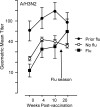Granzyme B: Correlates with protection and enhanced CTL response to influenza vaccination in older adults
- PMID: 19368783
- PMCID: PMC2800816
- DOI: 10.1016/j.vaccine.2009.01.136
Granzyme B: Correlates with protection and enhanced CTL response to influenza vaccination in older adults
Abstract
This study compared serum antibody titers and granzyme B (GrzB) levels in virus-stimulated peripheral blood mononuclear cells following influenza vaccination. Twelve of 239 older adults who subsequently developed laboratory-diagnosed influenza illness (LDI) had significantly lower GrzB levels compared to subjects without LDI (p=0.004). Eight subjects with LDI in the previous year showed an enhanced GrzB response to vaccination (p=0.02). Serum antibody titers following vaccination did not distinguish those older adults who developed LDI from those who did not. These results suggest that GrzB levels could be combined with antibody titers to more effectively predict vaccine efficacy in older adults.
Figures




References
-
- Thompson WW, Shay DK, Weintraub E, Brammer L, Bridges CB, Cox NJ, et al. Influenza-associated hospitalizations in the United States. Jama. 2004;292(11):1333–40. - PubMed
-
- Thompson WW, Shay DK, Weintraub E, Brammer L, Cox N, Anderson LJ, et al. Mortality associated with influenza and respiratory syncytial virus in the United States. Jama. 2003;289(2):179–86. - PubMed
-
- Effros RB. Role of T lymphocyte replicative senescence in vaccine efficacy. Vaccine. 2007;25(4):599–604. - PubMed
-
- McMichael AJ, Gotch FM, Noble GR, Beare PA. Cytotoxic T-cell immunity to influenza. N Engl J Med. 1983;309(1):13–7. - PubMed
Publication types
MeSH terms
Substances
Grants and funding
LinkOut - more resources
Full Text Sources
Medical

